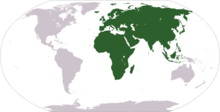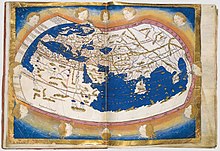Old World
This article needs additional citations for verification. (March 2013) |



The "Old World" (Latin: Mundus Vetus) is a term for Afro-Eurasia coined by Europeans after 1493, when they became aware of the existence of the Americas.[1] It is used to contrast the continents of Africa, Europe, and Asia in the Eastern Hemisphere, previously thought of by the Europeans as comprising the entire world, with the "New World", a term for the newly encountered lands of the Western Hemisphere, particularly the Americas.[2]
While located closer to Afro-Eurasia within the Eastern Hemisphere, Australia is considered neither an Old World nor a New World land, since it was only discovered by the Europeans later. Both Australia and Antarctica were associated instead with the Terra Australis that had been posited as a hypothetical southern continent.
Etymology
[edit]In the context of archaeology and world history, the term "Old World" includes those parts of the world which were in (indirect) cultural contact from the Bronze Age onwards, resulting in the parallel development of the early civilizations, mostly in the temperate zone between roughly the 45th and 25th parallels north, in the area of the Mediterranean, including North Africa. It also included Mesopotamia, the Persian plateau, the Indian subcontinent, China, and parts of Sub-Saharan Africa.
These regions were connected via the Silk Road trade route, and they had a pronounced Iron Age period following the Bronze Age. In cultural terms, the Iron Age was accompanied by the so-called Axial Age, referring to cultural, philosophical and religious developments eventually leading to the emergence of the historical Western (Hellenism, "classical"), Near Eastern (Zoroastrian and Abrahamic) and Far Eastern (Hinduism, Buddhism, Jainism, Sikhism, Confucianism, Taoism) cultural spheres.
Other names
[edit]The mainland of Afro-Eurasia (excluding islands or island groups such as the British Isles, Japan, Sri Lanka, Madagascar and the Malay Archipelago) has been referred to as the World Island. The term may have been coined by Sir Halford John Mackinder in The Geographical Pivot of History.[3]
References
[edit]- ^ "Old World". Merriam-Webster Dictionary. Archived from the original on 2 April 2019. Retrieved 3 December 2014.
- ^ "New world". Merriam-Webster Dictionary. Archived from the original on 2 April 2019. Retrieved 2 April 2013.
- ^ See Francis P. Sempa, "Mackinder's World" Archived 3 March 2016 at the Wayback Machine. American Diplomacy (UNC.edu). Retrieved 8 September 2018.











